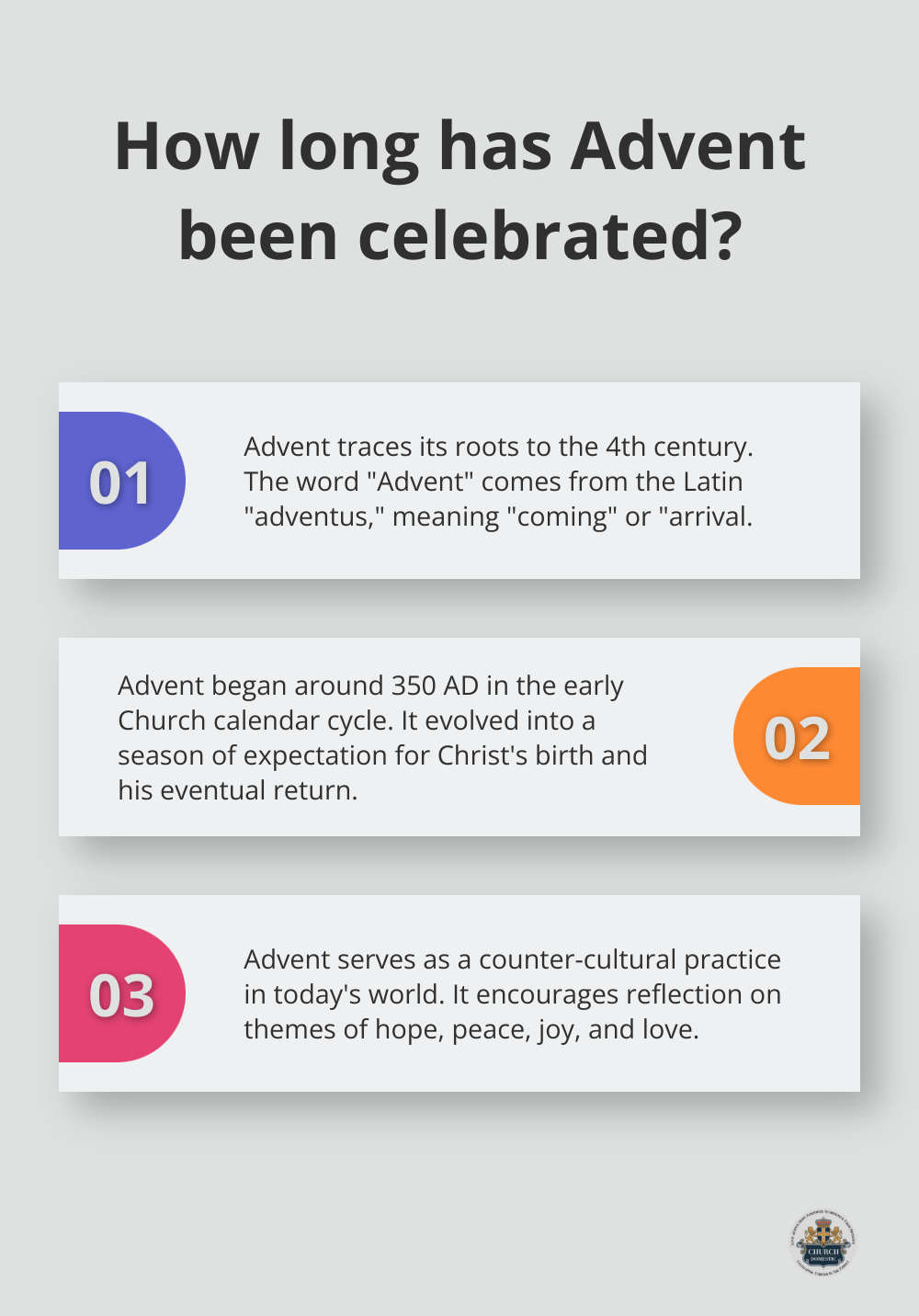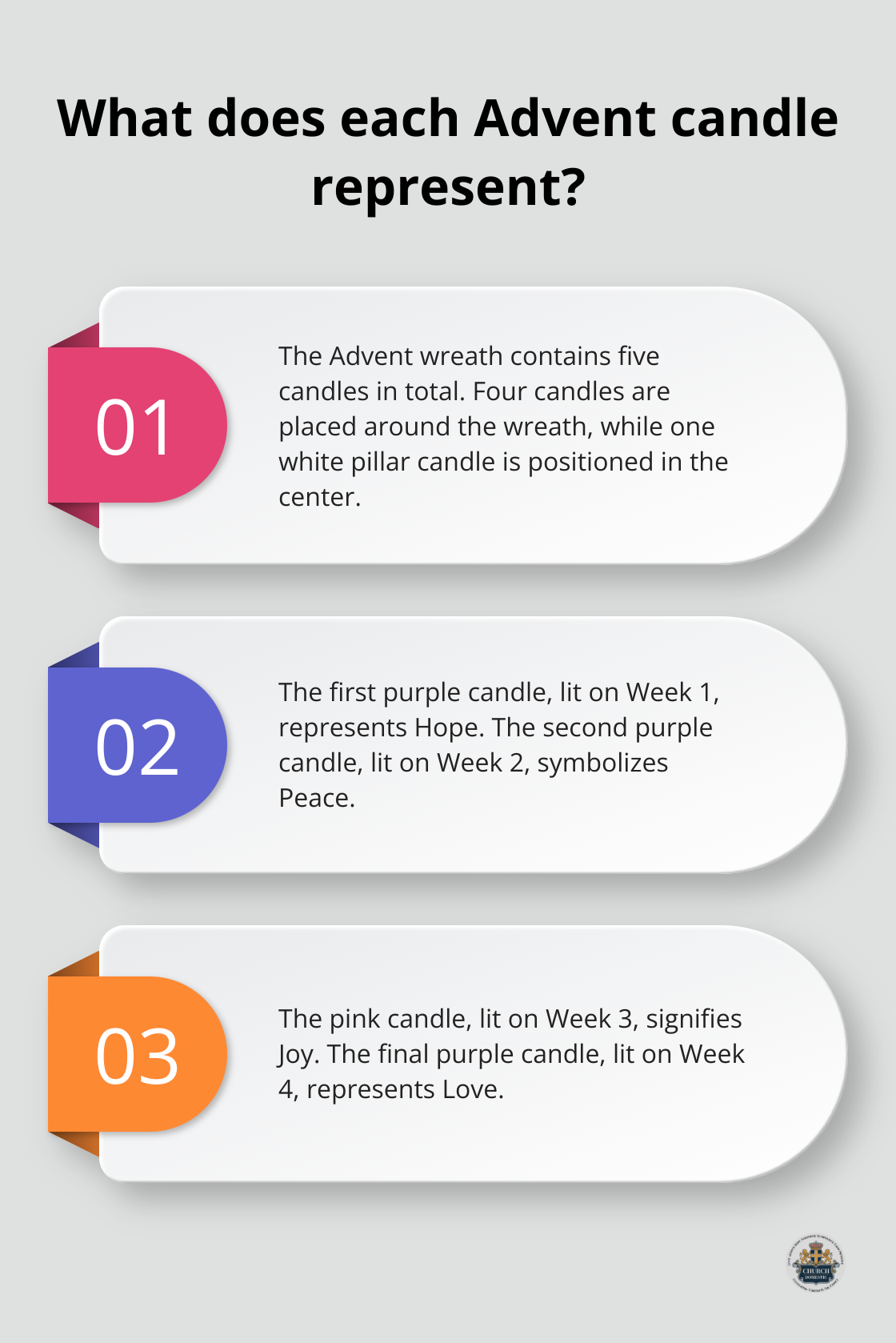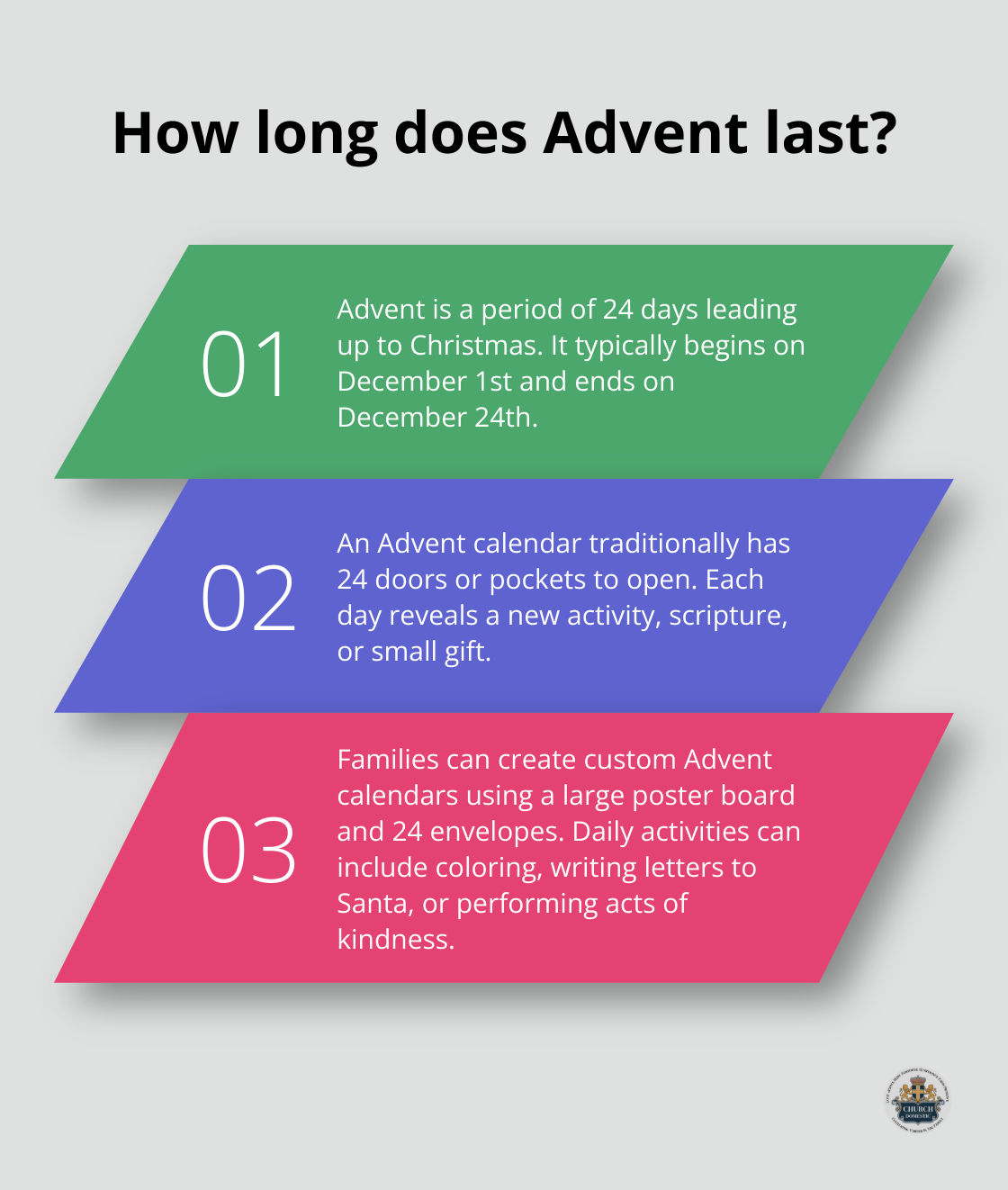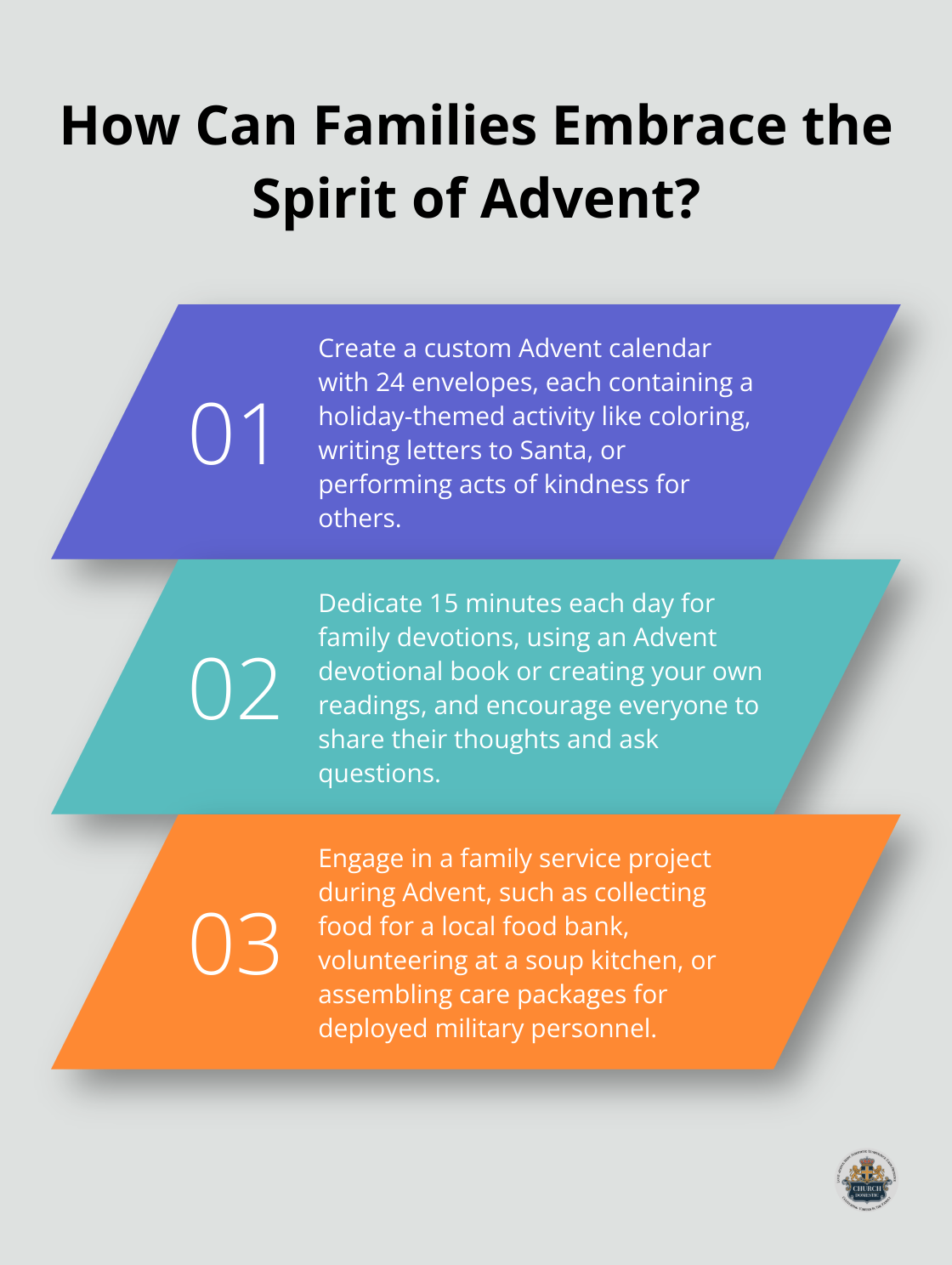At Church Domestic, we believe Advent is a powerful time for families to grow closer to each other and their faith. This season offers a unique opportunity to create meaningful rituals that can become cherished traditions.
In this post, we’ll explore how to incorporate faith traditions into your family’s Advent observance. From crafting an Advent wreath to engaging in daily activities, we’ll provide practical tips to make this season truly special for your loved ones.
Why Advent Matters
The Origins of Advent
Advent traces its roots to the 4th century when the early Church calendar cycle (around 350 AD) began to include celebrations of Saints and Martyrs. The word “Advent” comes from the Latin “adventus,” meaning “coming” or “arrival.” Over time, it evolved into a season of expectation for Christ’s birth and his eventual return.
Spiritual Significance in Christian Life
In today’s fast-paced world, Advent serves as a counter-cultural practice. It invites us to slow down and focus on the true meaning of Christmas. This season encourages reflection on themes of hope, peace, joy, and love – qualities often overshadowed by the commercial aspects of the holidays.
Family Benefits of Observing Advent
Observing Advent as a family yields numerous benefits. It creates a shared experience that strengthens family bonds. Children learn valuable lessons about patience and anticipation in a world of instant gratification. A study by the American Psychological Association found that families who engage in regular spiritual activities report stronger emotional connections and improved communication.

Advent rituals can transform family dynamics. Some families report that nightly Advent readings lead to deeper conversations about faith and values (something they previously struggled with). Others notice their children’s understanding of giving grows significantly after participating in daily acts of kindness throughout the season.
Teaching the Christian Narrative
Advent provides a framework for teaching children about the broader narrative of the Christian faith. Through stories, symbols, and rituals, families can explore the Old Testament prophecies and the events leading up to Jesus’ birth. Choosing an Advent tradition for your church allows you to celebrate the coming of Jesus alongside Christians all over the world.
A Buffer Against Holiday Stress
Intentional Advent observance creates a buffer against the stress and commercialism that often accompany the holiday season. It’s an opportunity to refocus on what truly matters – faith, family, and community.
As we move forward, let’s explore how to create an Advent wreath and establish a meaningful candle lighting ceremony – practices that will enrich your family’s Advent experience.
Creating Your Family Advent Wreath
At Church Domestic, we believe the Advent wreath can bring your family together in anticipation of Christmas. Let’s explore how to create and use this meaningful centerpiece for your Advent celebrations.
Gathering Your Materials
To make your Advent wreath, you’ll need:
- A circular wreath base (natural evergreen or artificial)
- Four candles (three purple, one pink)
- One white pillar candle for the center
- Candle holders
- Decorative elements (ribbons, pinecones, berries)

Pro tip: Ask your children to choose decorations. This gives them ownership of the process and ignites excitement for the coming weeks.
Understanding the Candles
Each candle on your Advent wreath holds special significance:
Week 1 (Purple): Hope
Week 2 (Purple): Peace
Week 3 (Pink): Joy
Week 4 (Purple): Love
Center (White): Christ
The progressive lighting of candles builds anticipation, mirroring the growing excitement as Christmas approaches.
Weekly Lighting Ceremony
Turn your candle lighting into a cherished family moment each Sunday of Advent. Here’s a simple structure:
- Gather around the wreath
- Light the appropriate candle(s)
- Read a short Bible passage
- Say a brief prayer
- Sing a verse of an Advent hymn
For example, on the first Sunday, you might read Isaiah 9:2-7 about the coming of the Prince of Peace. Follow with a prayer for hope in the coming year.
Engaging Children in the Ritual
Children thrive on participation. Assign roles to make the ceremony interactive. Each Advent reading can include readings, a song, Scripture readings, prayer, the lighting of a candle, and discussion questions.
Consistency is key. Set a regular time for your ceremony – perhaps Sunday evenings before dinner – to establish a rhythm your family can look forward to each week.
Creating and using an Advent wreath doesn’t just decorate your home. It builds a powerful visual reminder of the season’s true meaning and creates lasting family memories centered on faith.
As we light our Advent candles, we prepare our hearts for the next important aspect of family Advent traditions: daily activities that strengthen bonds and deepen faith. Let’s explore how to incorporate these meaningful practices into your family routine.
Enriching Family Advent Traditions
Creating a Family Advent Calendar
An Advent calendar transforms your family’s holiday experience. Instead of store-bought calendars with candy, create a custom calendar with daily holiday-themed activities. Use a large poster board and 24 envelopes. Each day, open an envelope to reveal the day’s activity.

For activities, include coloring, writing letters to Santa, math games, and other fun tasks. You can also incorporate scripture readings or acts of kindness. Begin with Old Testament prophecies and progress towards the Nativity. For acts of kindness, include simple tasks like “Write a thank-you note to your teacher” or “Help a neighbor with a chore.”
Establishing Daily Devotional Time
Dedicate 15 minutes each day for family devotions. Choose a time when everyone is usually home (perhaps after dinner or before bedtime). Use an Advent devotional book or create your own readings.
The Fuller Youth Institute has uncovered reasons young people persist in their faith and commit to evangelical Protestant churches after high school. Make your devotional time interactive by asking questions and encouraging everyone to share their thoughts.
Crafting Advent-Themed Decorations
Include your children in creating Advent-themed decorations. This activity not only beautifies your home but also reinforces the season’s meaning. Here are some ideas:
- Make a paper chain countdown, remove one link each day.
- Create a Nativity scene using craft materials, add one character daily.
- Decorate a Jesse Tree with ornaments representing Jesus’ family tree.
These crafts provide opportunities for learning and bonding.
Engaging in Service Projects
Advent offers an ideal time to teach children about giving. Select age-appropriate service projects that your family can do together. Some options include:
- Collect food for a local food bank
- Volunteer at a soup kitchen
- Assemble care packages for deployed military personnel
Try to create meaningful traditions that work for your family. Start small and maintain consistency. These activities will evolve into cherished rituals that bring your family closer to each other and to the true meaning of Christmas.
Final Thoughts
Advent rituals offer a unique opportunity to strengthen family bonds and deepen faith. We at Church Domestic hope you’ve found inspiration to create meaningful traditions that resonate with your family’s values and schedule. These faith traditions can transform your family’s experience of the Christmas season, focusing on the spiritual significance amidst the holiday bustle.

Start small and stay consistent with your chosen Advent practices. Adapt your rituals as your family grows and changes, always keeping the focus on preparing your hearts for the true gift of Christmas. This season invites us to pause and reflect on hope, peace, love, and joy in a world that often emphasizes material gifts and hectic schedules.
For more resources on family life and faith, visit us at Church Domestic. We support you in your journey of faith and family throughout the year. May your Advent season overflow with meaningful moments and the true spirit of Christmas.